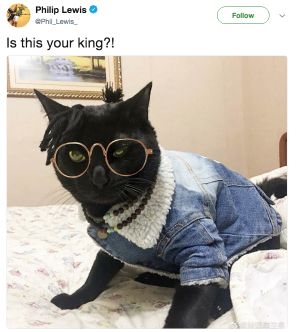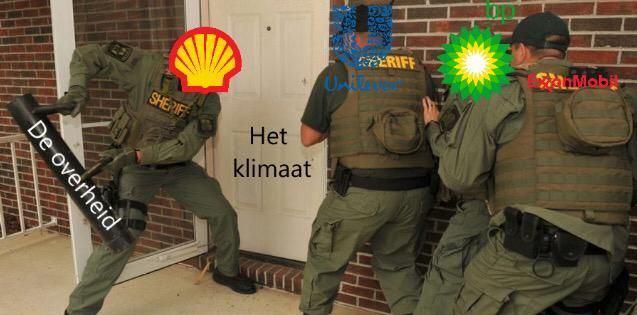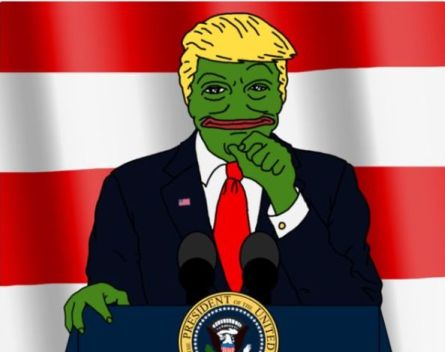Wat hebben kattenfilmpjes, de als Trump vermomde stripfiguur Pepe the Frog en het griezelfenomeen Slenderman met elkaar te maken? Het zijn allemaal internet-memes. Ik moet bekennen dat ik die term pas leerde kennen toen ik deze week op het IFFR in het Rabbit Hole dook. Rabbit Hole is de titel van een van de meer curieuze programma-onderdelen op het Rotterdamse filmfestival. Het internet als het konijnenhol uit Alice in Wonderland. Je stapt erin en je hebt geen idee waar je uitkomt. Bijvoorbeeld bij het extreem-bizarre feministische filmtraktaat Make Me Up.
Aldus presenteert het IFFR een reeks korte en enkele lange films die op een of andere manier door memes zijn geïnspireerd. Daarnaast is er in een hoek van Het Nieuwe Instituut een Meme Café ingericht. Een soort internet-café met computerschermen waarop kunstenaars hun visie op de meme-wereld presenteren. Zelf memes maken kan daar ook – maar misschien deed u dat al lang. In het Meme Café heb ik me over het fenomeen bij laten praten door programmeur Inge de Leeuw en door Aria Mag en Silvia dal Dosso, mede-oprichters van het artistieke onderzoekscollectief Clusterduck.
Een kleine meme-geschiedenis
Het oudere begrip ‘meme’ kende ik al wel. Bioloog Richard Dawkins muntte die term in 1976. Het staat voor ideeën of concepten die zichzelf in de menselijke cultuur voortplanten, vermeerderen en aanpassen. Zoals: het wiel, kleren dragen, stopwoordjes, mode, populaire melodieën, kapitalisme. Het is een breed spectrum. Ook Wilders’ ‘meer of minder’ is een meme geworden.
En welk medium is nu beter geschikt om memes viraal te laten gaan dan het internet? Vandaar dat sinds pakweg de jaren negentig de term ‘internet-meme’ gebruikt wordt voor allerlei informatie, slogans, beeldgrappen en aanstekelijke filmpjes die zich via sociale netwerken en webplatforms verspreiden. Ook dit is heel breed, maar vaak wordt het begrip internet-meme vernauwd tot een (bewerkte) foto of cartoon. Die door een internet-gebruiker voorzien is van een grappige of uitdagende tekst. Wat anderen weer kan inspireren om daarop te variëren. Want zonder hergebruik is het geen meme. Zoals bijvoorbeeld gebeurde met de quote ‘Is This Your King‘ en bijbehorend screenshot uit Black Panther.

Er zijn internet-memes met gekke dansjes, met de veelzijdige cartoonfiguur Octocat, en er zijn niches op internet waar meisjes de meme-taal gebruiken om problemen te bespreken. Een minder onschuldig meme-fenomeen dat wild om zich heen heeft gegrepen is Slender Man, waarover straks meer. Het Rabbit Hole-programma is zelfs van start gegaan met een heuse meme-battle, waar bezoekers hun meme-creativiteit konden testen. Ter illustratie de meme van mijn collega Hugo Emmerzael, die daarmee tweede werd.

Meme propaganda
Wie denkt dat het allemaal alleen maar speels is moet ook eens kijken naar deze internet-meme die laat zien hoe de populaire figuur Pepe the Frog werd ingezet in de Trump-campagne. Zoals ook grote bedrijven soms van internet-memes gebruik maken. Dan heet het virale marketing.

#MEMEPROPAGANDA van Clusterduck en aanverwante projecten zijn een mooi begin om verder in deze materie rond te neuzen. De vanuit Baltimore opererende filmcriticus Eric Allen Hatch, ook in het Meme Café, gebruikt internet-memes zelfs als een vorm van ultra-minimalistische filmkritiek.
Slenderman
Voor wie geen zin heeft om op het IFFR achter een computerscherm te kruipen is er ook het nodige in de bioscoopzaal. Naast een reeks korte films bijvoorbeeld de documentaire A Self-Induced Hallucination waarin Dan Schoenbrun het Slenderman-fenomeen portretteert. Helemaal in stijl volledig samengesteld uit YouTube-clips. Een mooi staaltje montagewerk, en wat mij betreft toch ook een bewijs dat de traditionele filmvorm het nog lang niet heeft afgelegd tegen de internet-doolhof.
De Slenderman-figuur is een griezelige lange slungel zonder gezicht. Hij dook in 2009 voor het eerst op als resultaat van een Photoshop-wedstrijd. Eric Knudsen had een enge figuur toegevoegd aan enkele foto’s. Vervolgens ging het via sociale media in kringen van horrorfans razendsnel een eigen leven leiden. Slenderman werd een moderne mythologische figuur. Eigenlijk net zoals in vroeger tijden in de volkscultuur mythische figuren ontstonden, alleen gingen er toen eeuwen overheen.
Slenderman werd zelfs berucht toen in 2014 twee twaalfjarige, naar ik begrepen heb schizofrene meisjes zich door hem lieten inspireren tot een bijna fatale steekpartij. Tamelijk recent was er ook de door Sony geproduceerde horrorfilm Slender Man. Van underground naar mainstream.
Feministische satire
Spectaculair bizar is Make Me Up van Rachel Maclean, beslist een van de meest wonderlijke films hier in Rotterdam. Een feministische satire annex video-essay op speelfilmlengte dat misschien niet letterlijk over internet-memes gaat, maar in stijl en geest is gemaakt. Gegoten in een overdaad aan zuurtjeskleuren die pijn doet aan je ogen.
Het verwijst daarmee naar de manier waarop meisjes of vrouwen zich soms online presenteren, maar dan helemaal over de top. Make Me Up gebruikt die ultra-kitsch als een startpunt voor een vindingrijk geconstrueerd, venijnig cultuurpolitiek commentaar. Propvol verwijzingen naar het vrouwbeeld in cultuur en kunst, en naar de tegenstrijdige krachten waar vrouwen aan blootstaan.
Live-streamende Chinezen
Hoe de echte wereld en die van sociale media verstrengeld raken is ook mooi te zien in Present.Perfect., over jonge Chinezen die hun leven via live-streams met de wereld delen. Deze geheel uit internetbeeld samengestelde documentaire van Zhu Shengze zit niet in het Rabbit Hole-programma, maar maakt deel uit van de Tiger Competitie. Wat aanvankelijk een tikje curieus lijkt, groeit langzaam uit tot een prachtige reeks portretten van een aantal Chinezen aan de onderkant van de samenleving. Hunkerend naar menselijk contact proberen ze via vlogs en internet-chats te vinden wat ze in het werkelijke leven missen.
